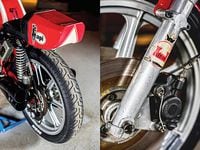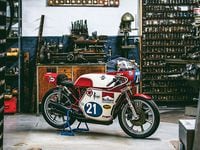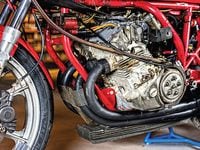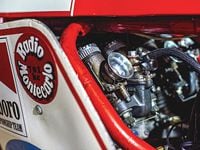Like so many other motorcycle firms that popped up in Europe immediately following World War II, MV Agusta's beginnings were humble. "M" for Meccanica, "V" for Verghera—the small Italian town where the firm was based—and "Agusta" for the family that controlled the firm, the manufacturer was a spin-off of the Agusta aviation company and was originally founded to provide cheap, fuel-efficient transportation for war-ravaged Italy. But founders Count Vincenzo Agusta and his brother Domenico were passionate about motorcycle racing. As soon as the firm turned its first profit, they immediately created a racing department and set out to build the best Grand Prix motorcycle team in the world. By the time MV Agusta retired from Grand Prix competition in 1976—the year this bike won its last race—the firm had won 275 GP races, 38 World Riders' Championships, and 37 World Constructors titles. Mission accomplished.
This 350cc Quattro Cilindri (four cylinder) debuted in 1972, a higher-revving and more compact replacement for the legendary—but aging—MV Agusta triples that won the 350 World Championship every year from 1968–'73. The writing was already on the wall for the four-stroke MV Agusta racers by '72, and the only way to close the power gap with emergent and much more potent two-stroke competition was to build revs to a stratospheric level. By the time the 1976 season rolled around, MV Agusta engineers had pushed the Quattro Cilindri engine architecture to the absolute limit to compete with the then-dominant two-strokes from Yamaha and Harley-Davidson/Aermacchi.
What you see here is cutting-edge Grand Prix racing technology for the mid-’70s and the ultimate development of the MV Agusta four-stroke Grand Prix platform. Lead Engineer Ruggero Mazza designed the ultra-short-stroke (54 x 38mm), air-cooled inline-four to safely rev to 16,500 rpm, where it produces 77 hp to achieve a top speed of around 170 mph. The Arturo Magni-designed open-cradle duplex frame is titanium. Although previous MV Agusta racers were patriotic to the extreme, this represents an era when MV Agusta sourced the best components from around the world. The magnesium Ceriani forks and Marzocchi piggyback shocks are home-grown Italian pieces, but Morris mag wheels, Bosch electronics, Lockheed calipers, and plasma-sprayed Hunt alloy brake rotors contribute to a pan-European pedigree.
Despite MV Agusta's best efforts—and millions of Italian lire spent—the 350 Quattro Cilindri struggled on-track. Its history is largely one of difficulty, as mechanics tried desperately to wring every last horsepower from the 16-valve, air-cooled four. Not even a last-ditch change from a gear-driven magneto to electronic ignition—hence the "Electronica" nickname for this bike—could improve performance. This machine was effectively mothballed in 1974. Not coincidentally, two-stroke Yamahas and Harley-Davidsons combined won all 20 350 GP races in the 1974 and '75 seasons.
Fifteen-time World Championship winner Giacomo Agostini got his first big break in 1963, when he was hastily signed by the Morini team to replace star rider Tarquinio Provini, who had defected to Benelli. But it wasn’t until after he won the 350cc Italian National Championship in 1964 with Morini, and caught the eye of Count Domenico Agusta, that Ago’s career really took off. He signed to ride for MV Agusta in 1965 as Mike Hailwood’s teammate. When Hailwood left for Honda at the end of that season, fleeing the legendarily difficult Count Agusta, Ago became MV Agusta’s top rider.
The combination of Italian man on Italian machine proved virtually unbeatable. Ago won the 500cc World Championship seven times in succession for the Italian manufacturer. He also won the 350cc title seven years in a row (six on MV Agusta machines), as well as 10 Isle of Man TTs. The Isle of Man TT was the most prestigious race on the motorcycle calendar, and Ago shocked the world by boycotting that race after the death of his close friend Gilberto Parlotti in the 1972 TT. Other top riders joined his protest, and by 1977 the TT was struck from the Grand Prix calendar. Ago commanded that much power in the racing world.
MV Agusta’s factory racing program was in disarray by the mid-’70s, suffering a leadership void after Count Domenico, the firm’s guiding force, died in 1971. A hostile takeover of the Agusta family’s helicopter business—which had in large part funded the Grand Prix racing effort—led to further decline, and Ago eventually left MV Agusta to race for Yamaha in 1974. Ago had been accused of sandbagging for years, battling privateers on the overachieving factory MVs, but the switch to Yamaha proved his talent was real.
He won the 1974 350 GP title with Yamaha then followed up with the 500 GP title in 1975—the first time a two-stroke machine won the premier class. Ago formed his own team in 1976, with sponsorship from tobacco giant Marlboro, competing on both MV Agusta and Yamaha machinery in both the 350 and 500 classes. When he won at Assen riding this MV Agusta 350 Quattro Cilindri, it marked the final 350 GP win for himself, for MV Agusta, and for a four-stroke engine in the 350cc class.
The motorcycle racing world laughed when Ago first wheeled the 350 Quattro Cilindri out of storage for the 1976 season. “Start-money special,” they derisively called the bike. Ago’s quest to use the four-stroke MV to outcompete the cheaper, faster, and more reliable two-strokes in the 350 GP class was considered hopeless.
Early results supported the skepticism. The bike retired from the French GP with ignition trouble then dropped out of the Austrian GP with a failed clutch. The wrong gearing selection held the bike back at Italy, but it didn’t break. The next mechanical failure was at the Yugoslav GP, where it holed a piston. The Dutch TT at Assen was the only exception that season. It was a brutally sunny day, and the hot conditions proved fatal for much of the two-stroke competition, which seized left and right. Two-stroke teams were forced to detune for reliability, which gave the air-/oil-cooled MV an advantage.
Ago was never challenged that afternoon, leading from flag to flag, turning the fastest lap of the race, and taking the win by a massive 25 seconds. His victory was so decisive that competitors protested the result, claiming the bike was a 500 in 350 disguise. (A post-race teardown measured displacement at exactly 348cc.) It was a brilliant victory and the very last for this bike. Ago would win one more time that 1976 season, at the penultimate round at Germany's Nürburgring, but aboard the 500cc MV Agusta. It would be the last Grand Prix win for a four-stroke motorcycle until the modern MotoGP era. Simpler, cheaper, two-stroke technology would ultimately put the MV Agusta racing team out of business.
After that last season, the 350 Quattro Cilindri languished under a sheet in a corner of MV Agusta’s Cascina Costa racing shop for 10 years. In 1986, Brooklyn-based vintage racing outfit Team Obsolete acquired it along with more than a dozen other historic MV Agusta racebikes and spares in a deal journalists described as “the sale of the century.”
One of the pioneers of vintage roadracing in America, and still one of the sport’s greatest global benefactors, Team Obsolete’s Rob Iannucci got his start collecting and racing British-built Matchless G50s. His collection includes some of the most historically significant racebikes ever built, ridden by iconic heroes like Cal Rayborn, Dick Mann, Jim Redman, and of course Giacomo Agostini. Iannucci has enough ex-factory, ex-Agostini MV Agustas “to grant him honorary Italian citizenship,” jokes his friend Stu Carter.
Iannucci and other Team Obsolete technicians refreshed the 350 Quattro Cilindri and returned it to running order in the mid-1990s. The bike was in surprisingly good condition, Iannucci notes, and it appeared to have been recently rebuilt—only the rings and valve springs needed replacing. Iannucci strives to maintain his collection in as-raced condition, so his crew only rebuilt the engine and serviced the chassis. The paint and everything else remains absolutely original, exactly as it presented in 1976.
Ago himself was the first to ride the bike in the Team Obsolete era during a parade lap at the Dutch TT 70th anniversary celebration at Assen Raceway in 1995. The bike has since been ridden and raced sporadically since then at various vintage-racing venues, by Ago and other riders. He’s raced Team Obsolete-owned MV Agustas more than a dozen times. Iannucci comes squarely from the “ride ’em, don’t hide ’em” school of racebike collecting, and he wasn’t shy about giving us the opportunity to turn a few laps on this precious machine.
We met with Iannucci and a small army of Team Obsolete staff on a crisp May day at Thompson Speedway Motorsports Park in Thompson, Connecticut, a 1.7-mile road course tucked into the rolling hills of New England. Hosting its own annual vintage motorcycle festival, Thompson Speedway has become a destination for East Coast vintage-racing enthusiasts. It’s a great place, even if it’s not exactly Assen.
The first thing you notice about the Quattro Cilindri is its size—or lack thereof. It’s a tiny machine, roughly the same scale as a modern 125 GP bike, with a wheelbase of 50.5 inches, a seat that’s 26.9 inches from the ground, and a dry weight of 267 pounds. This is exactly what Ago liked—a bike that was tight, tidy, and easy to flick around. Team Obsolete also offered us the opportunity to ride an earlier, 1970 MV Agusta 350 triple. Compared to that bike, which defined a much more restrictive riding position, the Quattro Cilindri felt comfortable, almost modern. Instead of being locked into a cramped aerodynamic tuck, you can actually move around a bit on the newer bike to center your weight over the front end and shift your toes out of the way in deep corners.
But who cares about comfort when you’ve got such a screaming engine between your knees? There’s nothing that compares to the aural sex of the Quattro Cilindri approaching 17,000 rpm, wailing through its artfully curved quad-megaphone exhausts. Clearly powerful and unbelievably quick revving, the Quattro Cilindri lifts the front wheel coming onto Thompson’s back straight and tears through the revs all the way to nearly 140 mph before you have to dip into the strong double-disc front brakes.
A two-stroke, 350cc twin might feel nearly as fast but nowhere near as flexible as MV Agusta’s four-stroke four. This bike is much more forgiving at smaller throttle openings, with robust and easy-to-manage low-end torque. It’s pretty easy to understand why a great racer like Agostini was reluctant to abandon the soulful Quattro Cilindri, even after its usefulness on the Grand Prix circuit expired. It’s also easy to understand the enduring appeal of an original MV Agusta factory racer from the glory days of Grand Prix, when counts and playboys thought nothing of bankrupting a helicopter company to build amazing motorcycles that chased international roadracing glory. Say thanks for restless romantics like Rob Iannucci who keep this grand era alive and another thanks to him for sharing this remarkable racebike—the end of a long and legendary motorsports line.

















/cloudfront-us-east-1.images.arcpublishing.com/octane/S35YGSEMEZB4BLTDJTSZPF4GLA.jpg)
/cloudfront-us-east-1.images.arcpublishing.com/octane/5UOT6HPX2JFMRJAX6EH45AR4MQ.jpg)
/cloudfront-us-east-1.images.arcpublishing.com/octane/OKWOJWAKP5EP3OACCRRWPCIX2Q.jpg)
/cloudfront-us-east-1.images.arcpublishing.com/octane/2WF3SCE3NFBQXLDNJM7KMXA45E.jpg)
/cloudfront-us-east-1.images.arcpublishing.com/octane/G4MG6OUCJNBSHIS2MVVOTPX65E.jpg)
/cloudfront-us-east-1.images.arcpublishing.com/octane/IIGGWFOTOJGB7DB6DGBXCCMTDY.jpg)
/cloudfront-us-east-1.images.arcpublishing.com/octane/QSTCM6AVEZA5JJBUXNIQ3DSOF4.jpg)
/cloudfront-us-east-1.images.arcpublishing.com/octane/U4I7G625B5DMLF2DVIJDFZVV6M.jpg)
/cloudfront-us-east-1.images.arcpublishing.com/octane/B6XD6LS6IVCQPIU6HXDJSM3FHY.jpg)
/cloudfront-us-east-1.images.arcpublishing.com/octane/ICL63FEDDRDTTMINYICCEYGMDA.jpg)
/cloudfront-us-east-1.images.arcpublishing.com/octane/FCGZHQXRBZFLBAPC5SDIQLVF4I.jpg)
/cloudfront-us-east-1.images.arcpublishing.com/octane/WNOB6LDOIFFHJKPSVIWDYUGOPM.jpg)

/cloudfront-us-east-1.images.arcpublishing.com/octane/X33NU3E525ECRHXLNUJN2FTRKI.jpg)
/cloudfront-us-east-1.images.arcpublishing.com/octane/6KKT5NNL2JAVBOXMZYS5ZO76YA.jpg)
/cloudfront-us-east-1.images.arcpublishing.com/octane/J5RKG5O455GMPGQRF2OG6LRT7A.jpg)
/cloudfront-us-east-1.images.arcpublishing.com/octane/GX2CIZKQVRH2TATDM26KFG2DAE.jpg)
/cloudfront-us-east-1.images.arcpublishing.com/octane/ZWIDYSAKQZHD5BHREMQILXJCGM.jpg)
/cloudfront-us-east-1.images.arcpublishing.com/octane/CYUHJZCTSJCH3MRAQEIKXK7SCQ.jpg)
/cloudfront-us-east-1.images.arcpublishing.com/octane/LKOFINY56FCXJCANJ5M7ZDQUBY.jpg)
/cloudfront-us-east-1.images.arcpublishing.com/octane/4NBPDACMWJH63JQYJVK3QRBDZI.jpg)
/cloudfront-us-east-1.images.arcpublishing.com/octane/KKHQHRR3FJGX7H2IPU6RALMWG4.jpg)

/cloudfront-us-east-1.images.arcpublishing.com/octane/5IOFS5JAE5FOXMNA23ZRAVVYUU.jpg)